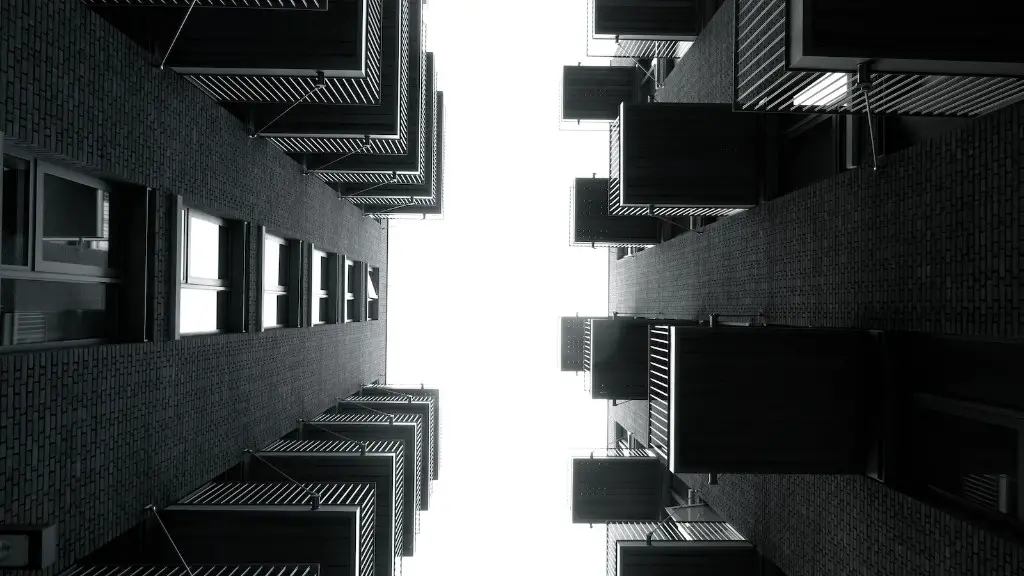Architecture is a field of study where art and science intersect to create amazing buildings and structures. Although it is known to be a creative field, it requires plenty of knowledge and skill. One of the key foundations of architecture is maths. Without maths, advanced designs could not have been created, and constructions made. Maths is found everywhere in architecture, from the calculations that govern renovations and restorations to the way structure of a skyscraper is constructed.
Maths plays an integral part in helping architects design buildings, as it ensures all measurements add up and fit into a space. Architects use trigonometry and geometry to measure structures and create accurate proportions for buildings, as well as for calculating the amount of materials needed for a project. They also use maths to determine the shape and size of beams and other components, such as cladding and rooflines. To make sure everything fits, architects use maths to ensure their measurements are precise and the building is safe and secure.
Without maths, architects would have no way to properly construct buildings or work out their measurements. Maths helps the architect to calculate the amount of material needed, calculate the construction costs, and, of course, the overall shape of the building. Maths is not only used in the construction process, but for the overall design too. Architects use variations of geometry, proportion, and ratios to decide how a building looks from the outside, and then how it looks from the inside.
Maths helps ensure a building has a certain amount of symmetry and balance. This helps the building to be strong and attractive, and allows architects to use certain design elements to ensure the building looks aesthetically pleasing. This is why maths is so important to architecture, as without maths, it would be impossible to create beautiful structures.
Maths is also used to plan and devise the energy efficiency of a building, which is essential in modern times. Maths principles and equations can be used to calculate solar energy, as well as calculate the amount of insulation needed, and the type of windows that are most energy efficient. This helps architects to create energy-efficient buildings that use the natural energy around them.
Maths is essential to architecture. Without maths, it would be impossible to create the amazing structures we have today, as it provides the foundations for construction and design. Maths allows architects to ensure a building is safe and secure, as well as aesthetically pleasing, and efficient in terms of energy use. It is clear to see why maths is such an important part of architecture.
The Role of Maths in Renovations and Restorations
When it comes to renovations and restorations, maths plays an integral role in ensuring the safety and success of the project. Maths helps the architect plan and design the renovation, as well as calculate the quantities of materials needed. This is especially important when renovating or restoring historical buildings, which often require extra calculations to ensure they remain safe and secure. Maths is used to calculate the load-bearing capacity of a building, as well as to determine the size and shape of the new materials that need to be installed.
Maths can be used to measure any existing sections of the building and figure out where new sections need to be added. This helps to ensure that the renovation is done correctly and the building has the required support. Maths is also used to calculate how much of a building needs to be restored, which is essential in historical renovations, as too much or too little renovation can have a dramatic effect on the building.
By using maths, architects can also compare the existing structure to the proposed structure to make sure the renovation will be safe and secure. This is especially important when constructing a building in a confined or dangerous area, such as near a river or an old building. Maths allows the architect to do the calculations needed so they can ensure the project is secure and within safety requirements.
Maths is also used to calculate any potential risk or danger associated with a renovation, such as the potential for flooding or the stability of certain sections. It also helps to figure out how much destruction a renovation may cause, especially if the materials used are flammable. Maths is essential for making sure renovations and restorations are done in the correct and safe manner.
Calculating Expansion in Buildings
Maths is also an important tool for working out the size and scope of a building’s expansion. When a building is expanded, the existing structure needs to be examined and calculations need to be made to see if it is safe and secure. Architects use maths to figure out the load-bearing capacity of the building and the amount of materials needed to avoid overload.
Maths also helps architects figure out the size and shape of the expansion. They use various equations and calculations to work out the building’s high points, low points, and angles in order to ensure there is enough room for the expansion. This helps to prevent any unnecessary destruction and make sure the expansion is symmetrical and aesthetically pleasing.
Architects also use maths to calculate the amount of energy required for a building and how much insulation needs to be used for the expansion. Insulation helps to prevent any heat or cold loss from the structure, which helps to make it more efficient and environmentally friendly.
Maths also helps architects calculate any potential structural or safety risks associated with an expansion. For example, if a building is to be enlarged, architects use maths to make sure the new structure is safe and not likely to cause any damage to the existing structure. Maths is essential in making sure an expansion is safe and secure, and that the building is attractive and efficient.
Measuring Skyscrapers
One of the most important uses of maths in architecture is in the construction of skyscrapers. Skyscrapers must meet certain requirements, and these can only be measured using maths. By using maths, architects can accurately measure the proportions of a building, calculate the amount of material needed, and ensure the skyscraper will be structurally sound. Designers must also account for gravity, wind, and other forces of nature, which requires advanced maths calculations.
Maths is also essential in ensuring a skyscraper is aesthetically pleasing. Architects use maths to determine the size and shape of the various components needed and then use these measurements to create the overall design of the building. This helps to make sure the building looks balanced and symmetrical, as well as attractive. Maths also helps architects to calculate the load-bearing capacity of a building, as it needs to withstand high wind speeds and other forces of nature.
When constructing a skyscraper, architects must use maths equations in order to calculate the most efficient ways to build the structure. They use equations to make sure the building will remain secure and safe even in strong winds, and that the foundations are laid correctly. This helps to ensure the skyscraper will remain standing for many years.
Without maths, construction of skyscrapers would be impossible. Advanced mathematics techniques are needed to calculate the size and shape of the structure, the amount of material required, and how the building will stand up against wind and other forces of nature. Maths is integral to the construction of skyscrapers and is essential for ensuring the building is safe and secure.
Understanding Wind Movement
Understanding wind movement is essential in architecture and can be complicated. Advanced maths calculations are used to figure out the speed and movement of wind around a building. This is useful when constructing high buildings, such as skyscrapers, as it helps to determine the building’s load-bearing capacity. Maths equations must be used to understand wind movement as it provides information on the building’s drag coefficient and wind pressure, as well as its wind-resisting capacity.
By understanding wind movement, architects can better design their buildings so that they are safe and secure. This is especially important when building tall structures, as wind movement has a huge impact on the stability of a building. Maths calculations must be made to figure out the wind speed and direction, as well as to understand how the building will react to wind movement.
Wind movement is also important for designing the exterior of a building. By understanding the movement of wind around a building, architects can better design the building to be aesthetically pleasing. They can use maths to calculate the angles of the windows and walls so that they are symmetrical and attractive. This helps to create a harmonious design that is pleasing to the eye.
Wind movement is essential to understand in the construction of a building, and maths is the tool to make sure it is understood. Maths equations are used to calculate wind speed and direction, as well as to determine the load-bearing capacity and aesthetic design of a building. Without maths, buildings would not be able to withstand the forces of nature, and designing buildings would be impossible.
Calculating Durability and Strength
Maths is also used to calculate the durability and strength of a building. As buildings are exposed to different weather conditions, having strong and durable components is essential. Maths equations are used to figure out how much force each component can bear, as well as how much material is needed to make sure the building is strong and secure.
Architects also use maths to calculate the strength of the building’s foundations. They use maths equations to predict the amount of force the structure will be subject to and then calculate the required amount of material needed to withstand these forces. Maths is essential in making sure a building is safe and secure and has the proper foundations.
By using maths equations, architects can also figure out the amount of insulation required to make sure a building is energy efficient. This helps them understand the amount of energy a building consumes and how much insulation is needed to keep it cool or warm. This is especially important in high-rise buildings, as their size and shape require more insulation to properly regulate the temperature inside.
Maths is integral to the strength and durability of a building. Architects use maths equations to calculate the load-bearing capacity, the amount of material needed, and the amount of insulation. Without maths, it would be impossible to measure these factors and ensure a building is safe, secure, and energy efficient.





